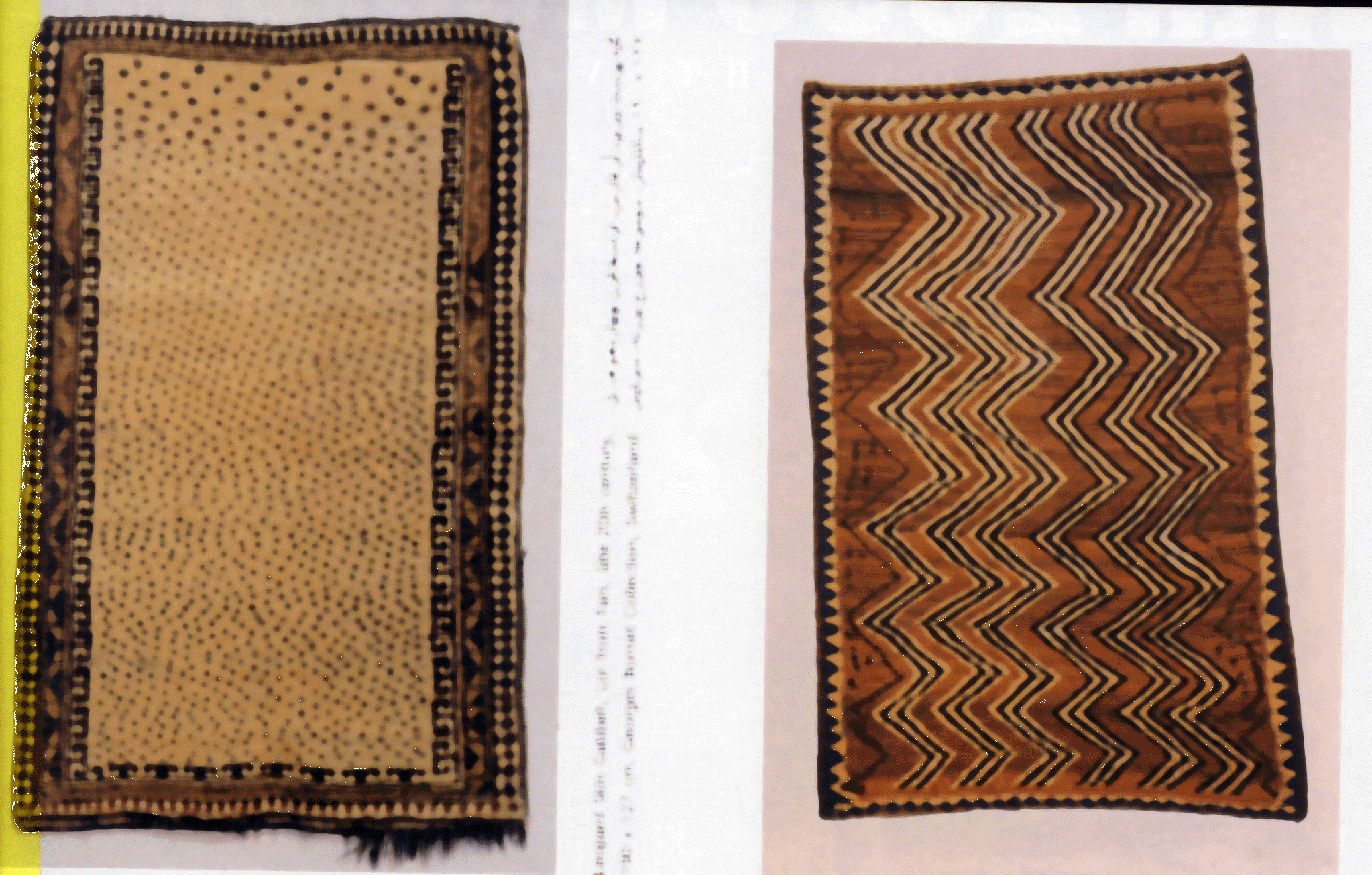| Carpets
known as leopard skin or tiger skin carpets are among
the most important Iranian carpet designs. Though
these carpets are mostly used by the dervishes, their
use is not limited to them and as we will see, many
other groups of people, including nomads, show much
interest in such designs. In past times, stripped
and patterned animal fur (like that of tigers and
leopards) was preferred to plain fur (like that of lions
and deer). Perhaps when man learned to weave, the
design of tiger and leopard skin held a special
attraction for him. There is no proof left of this
fact, but one can note the special passion nomads and
dervishes have for nature and animals and earth.
Most of what little these people have, has been given to
them by nature. The dishes they use for water and
food are no other than a type of sea coconut called
"coco de mer." Their cane and means of
defense is a thorny stick called "mantasha."
Metal dishes or steel axes are modern tools inspired by
the mentioned coconut and mantasha. As for
clothing, carpets, or blankets, it should be noted that
dervishes were happy with the minimum and would use a
piece of animal skin, or if not available, a torn piece
of cloth to cover themselves and to use as a carpet to
sit or sleep on. Even so, and despite such
poverty, dervishes think of themselves as no less than
kings. If kings rule with power and fortune,
dervishes rule the land of the poor. They use the
word "taj-e-shahi" (king's crown) to refer to
their dervish hats, while using the term "takht-e
shahi" (king's throne) to describe the animal skin
they sit or sleep on. They often use the title of
Shah (king) on their names with Shah Ne'matollah, Noor-Ali
Shah, and Moshtauq Ali Shah being a few examples.
The
connection between tools of the kings and the dervishes
is an elaborate matter, one I hope to discuss someday in
this same magazine. For this article, I will limit
the discussion to one such tool (i.e., leopard and tiger
skin).
The
study of the link between "leopard and tiger
skin" and kings and warriors in Iranian mythology
is a lengthy one. Ferdowsi designates
"tiger" clothing for Rostam [a mythical
hero] . Paintings from the fourteenth century show
such clothes on some kings and warriors. One of the
oldest of such paintings, believed to be from the late
thirteenth century, is kept in the Freer Art Gallery of
Washington and shows Kiumars, the first mythical king of
Iran, clothed in leopard skin and standing on a tiger
skin carpet. Another notable painting of Kiumars
is believed to be the work of Sultan Mohammad.
This painting, undoubtedly a masterpiece of the early
Safavid period, shows Kiumars and members of his court
in leopard garments while one of them is portrayed in a
tiger garment as well.

Kings
and dervishes have many things in common, the main
reason for this being the mutual tools and appearances
of the two. Both have everything they want, one
having gained all wealth and the other being a master in
poverty. Both are rulers of their lands, yet the king's
lands are limited by gates and fences, while there are
no limits or barriers to the dervish's land. As
for the leopard, tiger and also lion, it must be noted
that the kings portray their victory over these animals,
animals who are themselves kings of forests and jungles,
on rocks and mountains and in books. They use such
images to boast, and to imply: Your king is superior to
all powers." Dervishes know the earth to be
their absolute territory and thus show their dependence
to earth and dominance over its inhabitants by wearing
animal skins or sitting on them. The lifestyle of
nomads is not much different than that of dervishes and
kings. The gates to plains, mountains, and valleys
are open to the nomads. They settle their tents
wherever they wish and rule for a period of time.
They know their environment to be their own and have the
same close connection with the land, nature and animals
that dervishes have. They own sheep and have the
tools and skills to weave, so it's perfectly natural
that their women should weave carpets with designs from
leopard and tiger skin.
Leopard
and tiger carpets (as well as lion ones) are also
symbols of courage and bravery for the nomads. by
weaving and having such carpets on their floors,
the nomad women tell their children legends of how their
ancestors hunted down these animals. In the
process, they imply that their husband and children should
follow their ancestors in this demonstration of courage.
The
leopard and tiger skins that nomad women weave are not
exact copies of real leopard and tiger skins.
Possessing both the expertise to weave various designs
and the creativity to make ne3w designs, they go beyond
leopard and tiger designs. Sometimes, they cover
the whole surface of the carpet with the leopard and
tiger skin design, while at other times with the
addition of ne3w colors they change these designs from
bicolor to multicolor. They sometimes carry it so
far that it confuses the common spectator with no
knowledge of the source of such design, and reminds of
modern and contemporary carpet designs.
Though
leopard designs can be considered exclusively Iranian
and originating from Iran, tighter carpet have a much
wider homeland. this land stretches from China at
one end, to India on the other. Tibet has the
highest share in weaving tiger carpets. In Western
Asia, it is Iran and Turkey that hold the highest
shares. Turkey has mostly been active in Woven
textiles, while Iran has had a large share in both
textiles and carpets with tiger designs.
|